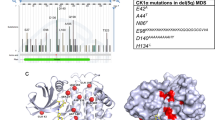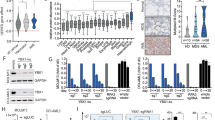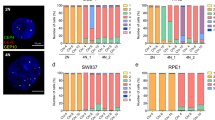Abstract
Centrosomes play fundamental roles in mitotic spindle organization, chromosome segregation and maintenance of genetic stability. Recently, we have shown that centrosome aberrations occur early in chronic myeloid leukemia (CML) and are induced by imatinib in normal fibroblasts in vitro. To investigate the influence of BCR-ABL on centrosomes, we performed long-term in vitro experiments employing the conditionally p210BCR-ABL-expressing (tetracycline-inducible promoter) human monocytic cell line U937p210BCR-ABL/c6 as a model of CML chronic phase. Centrosome hypertrophy was detectable after 4 weeks of transgene expression onset, increasing up to a rate of 25.7% aberrant cells within 13 weeks of propagation. This concurred with clonal expansion of aneuploid cells displaying a hyperdiploid phenotype with 57 chromosomes. Partial reversibility of centrosome aberrations (26–8%) was achieved under prolonged propagation (14 weeks) after abortion of induction and bcr-abl silencing using small interfering RNA. Therapeutic doses of imatinib did not revert the aberrant phenotype, but counteracted the observed reverting effect of bcr-abl gene expression switch off. Suggesting a mechanistic model that features distinct abl-related tyrosine kinase activity levels as essential determinants of centrosomal integrity, this is the first report mechanistically linking p210BCR-ABL oncoprotein activity to centrosomal hypertrophy.
This is a preview of subscription content, access via your institution
Access options
Subscribe to this journal
Receive 12 print issues and online access
$259.00 per year
only $21.58 per issue
Buy this article
- Purchase on Springer Link
- Instant access to full article PDF
Prices may be subject to local taxes which are calculated during checkout



Similar content being viewed by others
References
Sawyers CL . Chronic myeloid leukemia. N Engl J Med 1999; 340: 1330–1340.
Barnes DJ, Melo JV . Cytogenetic and molecular genetic aspects of chronic myeloid leukaemia. Acta Haematol 2002; 108: 180–202.
Calabretta B, Perrotti D . The biology of CML blast crisis. Blood 2004; 103: 4010–4022.
Hochhaus A, Weisser A, La Rosée P, Emig M, Müller MC, Saussele S et al. Detection and quantification of residual disease in chronic myelogenous leukemia. Leukemia 2000; 14: 998–1005.
Müller MC, Gattermann N, Lahaye T, Deininger MW, Berndt A, Fruehauf S et al. Dynamics of BCR-ABL mRNA expression in first-line therapy of chronic myelogenous leukemia patients with imatinib or interferon alpha/ara-C. Leukemia 2003; 17: 2392–2400.
Patel H, Marley SB, Gordon MY . Detection in primary chronic myeloid leukaemia cells of p210BCR-ABL1 in complexes with adaptor proteins CBL, CRKL, and GRB2. Genes Chromosomes Cancer 2006; 45: 1121–1129.
Johansson B, Fioretos T, Mitelman F . Cytogenetic and molecular genetic evolution of chronic myeloid leukemia. Acta Haematol 2002; 107: 76–94.
Babicka L, Zemanova Z, Pavlistova L, Brezinova J, Ransdorfova S, Houskova L et al. Complex chromosomal rearrangements in patients with chronic myeloid leukemia. Cancer Genet Cytogenet 2006; 168: 22–29.
Marx J . Cell biology. Do centrosome abnormalities lead to cancer? Science 2001; 292: 426–429.
Hahn WC, Weinberg RA . Rules for making human tumor cells. N Engl J Med 2002; 347: 1593–1603.
Pihan GA, Wallace J, Zhou Y, Doxsey SJ . Centrosome abnormalities and chromosome instability occur together in pre-invasive carcinomas. Cancer Res 2003; 63: 1398–1404.
Pihan GA, Purohit A, Wallace J, Malhotra R, Liotta L, Doxsey SJ . Centrosome defects can account for cellular and genetic changes that characterize prostate cancer progression. Cancer Res 2001; 61: 2212–2219.
Schneeweiss A, Sinn HP, Ehemann V, Khbeis T, Neben K, Krause U et al. Centrosomal aberrations in primary invasive breast cancer are associated with nodal status and hormone receptor expression. Int J Cancer 2003; 107: 346–352.
Krämer A, Schweizer S, Neben K, Giesecke C, Kalla J, Katzenberger T et al. Centrosome aberrations as a possible mechanism for chromosomal instability in non-Hodgkin's lymphoma. Leukemia 2003; 17: 2207–2213.
Bornens M . Centrosome composition and microtubule anchoring mechanisms. Curr Opin Cell Biol 2002; 14: 25–34.
Andersen JS, Wilkinson CJ, Mayor T, Mortensen P, Nigg EA, Mann M . Proteomic characterization of the human centrosome by protein correlation profiling. Nature 2003; 426: 570–574.
Löffler H, Lukas J, Bartek J, Krämer A . Structure meets function – centrosomes, genome maintenance and the DNA damage response. Exp Cell Res 2006; 312: 2633–2640.
Doxsey S, McCollum D, Theurkauf W . Centrosomes in cellular regulation. Annu Rev Cell Dev Biol 2005; 21: 411–434.
Nigg EA . Mitotic kinases as regulators of cell division and its checkpoints. Nat Rev Mol Cell Biol 2001; 2: 21–32.
Krämer A, Lukas J, Bartek J . Checking out the centrosome. Cell Cycle 2004; 3: 1390–1393.
Giehl M, Fabarius A, Frank O, Hochhaus A, Hafner M, Hehlmann R et al. Centrosome aberrations in chronic myeloid leukemia correlate with stage of disease and chromosomal instability. Leukemia 2005; 19: 1192–1197.
Fabarius A, Giehl M, Frank O, Duesberg P, Hochhaus A, Hehlmann R et al. Induction of centrosome and chromosome aberrations by imatinib in vitro. Leukemia 2005; 19: 1573–1578.
Hakansson P, Lassen C, Olofsson T, Baldetorp B, Karlsson A, Gullberg U et al. Establishment and phenotypic characterization of human U937 cells with inducible p210 BCR/ABL expression reveals upregulation of CEACAM1 (CD66a). Leukemia 2004; 18: 538–547.
Shaffer LG, Tommerup N (eds). . ISCN 2005, An International System for Human Cytogenetic Nomenclature. S Karger: Basel, 2005, pp 6–120.
Schoch C, Schnittger S, Bursch S, Gerstner D, Hochhaus A, Berger U et al. Comparison of chromosome banding analysis, interphase- and hypermetaphase-FISH, qualitative and quantitative PCR for diagnosis and for follow-up in chronic myeloid leukemia: a study on 350 cases. Leukemia 2002; 16: 53–59.
Wang YL, Lee JW, Cesarman E, Jin DK, Csernus B . Molecular monitoring of chronic myelogenous leukemia: identification of the most suitable internal control gene for real-time quantification of BCR-ABL transcripts. J Mol Diagn 2006; 8: 231–239.
Singer CF, Hudelist G, Lamm W, Mueller R, Handl C, Kubista E et al. Active (p)CrkL is overexpressed in human malignancies: potential role as a surrogate parameter for therapeutic tyrosine kinase inhibition. Oncol Rep 2006; 15: 353–359.
Barnes DJ, Schultheis B, Adedeji S, Melo JV . Dose-dependent effects of Bcr-Abl in cell line models of different stages of chronic myeloid leukemia. Oncogene 2005; 24: 6432–6440.
Barnes DJ, Palaiologou D, Panousopoulou E, Schultheis B, Yong AS, Wong A et al. Bcr-Abl expression levels determine the rate of development of resistance to imatinib mesylate in chronic myeloid leukemia. Cancer Res 2005; 65: 8912–8919.
Fossey SC, Ferreira-Gonzalez A, Garrett CT, Dumur CI, Vnencak-Jones CL . BCRABL transcript detection by quantitative real-time PCR: are correlated results possible from homebrew assays? Mol Diagn 2005; 9: 187–193.
Cortes J, O’Dwyer ME . Clonal evolution in chronic myelogenous leukemia. Hematol Oncol Clin North Am 2004; 18: 671–684.
Amiel A, Yukla M, Gaber E, Leopold L, Josef G, Fejgin M et al. Random aneuploidy in CML patients at diagnosis and under imatinib treatment. Cancer Genet Cytogenet 2006; 168: 120–123.
Parvin JD, Sankaran S . The BRCA1 E3 ubiquitin ligase controls centrosome dynamics. Cell Cycle 2006; 5: 1946–1950.
Sankaran S, Parvin JD . Centrosome function in normal and tumor cells. J Cell Biochem 2006; 99: 1240–1250.
Ko MJ, Murata K, Hwang D-S, Parvin JD . Inhibition of BRCA1 in breast cell lines causes the centrosome duplication cycle to be disconnected from the cell cycle. Oncogene 2006; 25: 298–303.
Foray N, Marot D, Randrianarison V, Venezia ND, Picard D, Perricaudet M et al. Constitutive association of BRCA1 and c-Abl and its ATM-dependent disruption after irradiation. Mol Cell Biol 2002; 22: 4020–4032.
Deutsch E, Jarrousse S, Buet D, Dugray A, Bonnet ML, Vozenin-Brotons MC et al. Down-regulation of BRCA1 in BCR-ABL-expressing hematopoietic cells. Blood 2003; 101: 4583–4588.
Acknowledgements
We thank Drs P Hakansson and T Fioretos (Department of Clinical Genetics, University Hospital, Lund, Sweden) for providing U937p210BCR-ABL/c6 and control cells. Imatinib mesylate was kindly supplied by Dr E Buchdunger (Novartis, Basel, Switzerland). We thank Dr C Haferlach for performing FISH analysis. The study was supported by grants from the Wilhelm Sander-Stiftung, München (grant 2004.148.1), the Albert und Anneliese Konanz-Stiftung, Heidelberg, Germany and the European Leukemia Net (ELN), contract no. LSHC-CT-2004-503216.
Author information
Authors and Affiliations
Corresponding author
Additional information
Supplementary Information accompanies the paper on the Leukemia website (http://www.nature.com/leu)
Supplementary information
Rights and permissions
About this article
Cite this article
Giehl, M., Fabarius, A., Frank, O. et al. Expression of the p210BCR-ABL oncoprotein drives centrosomal hypertrophy and clonal evolution in human U937 cells. Leukemia 21, 1971–1976 (2007). https://doi.org/10.1038/sj.leu.2404834
Received:
Revised:
Accepted:
Published:
Issue Date:
DOI: https://doi.org/10.1038/sj.leu.2404834
Keywords
This article is cited by
-
c-MYB is a transcriptional regulator of ESPL1/Separase in BCR-ABL-positive chronic myeloid leukemia
Biomarker Research (2016)
-
Centrosome aberrations in bone marrow cells from patients with myelodysplastic syndromes correlate with chromosomal instability
Annals of Hematology (2013)
-
Centrosomal targeting of tyrosine kinase activity does not enhance oncogenicity in chronic myeloproliferative disorders
Leukemia (2012)
-
BCR–ABL: a multi-faceted promoter of DNA mutation in chronic myelogeneous leukemia
Leukemia (2010)
-
BCR/ABL induces chromosomal instability after genotoxic stress and alters the cell death threshold
Leukemia (2009)



